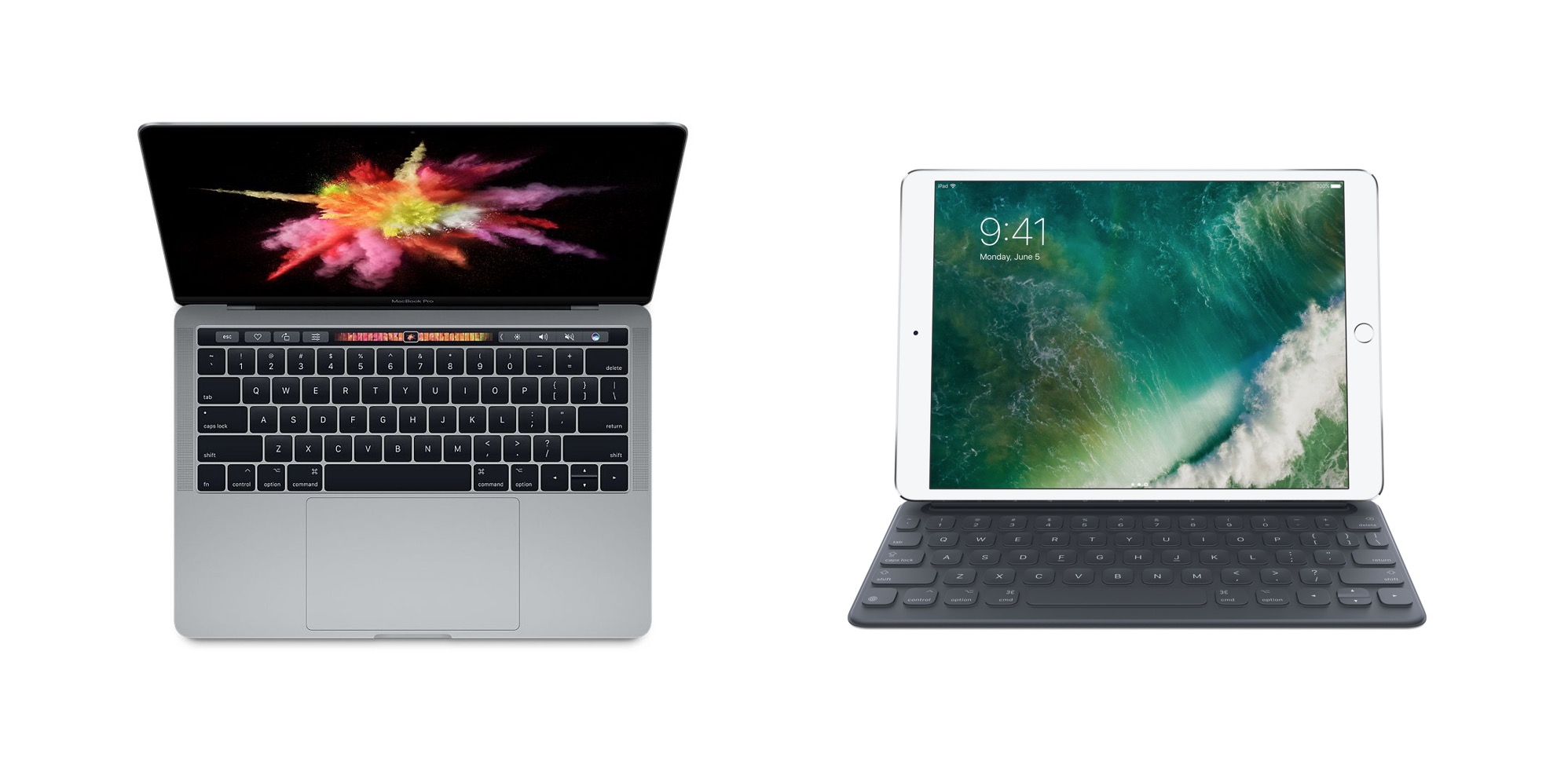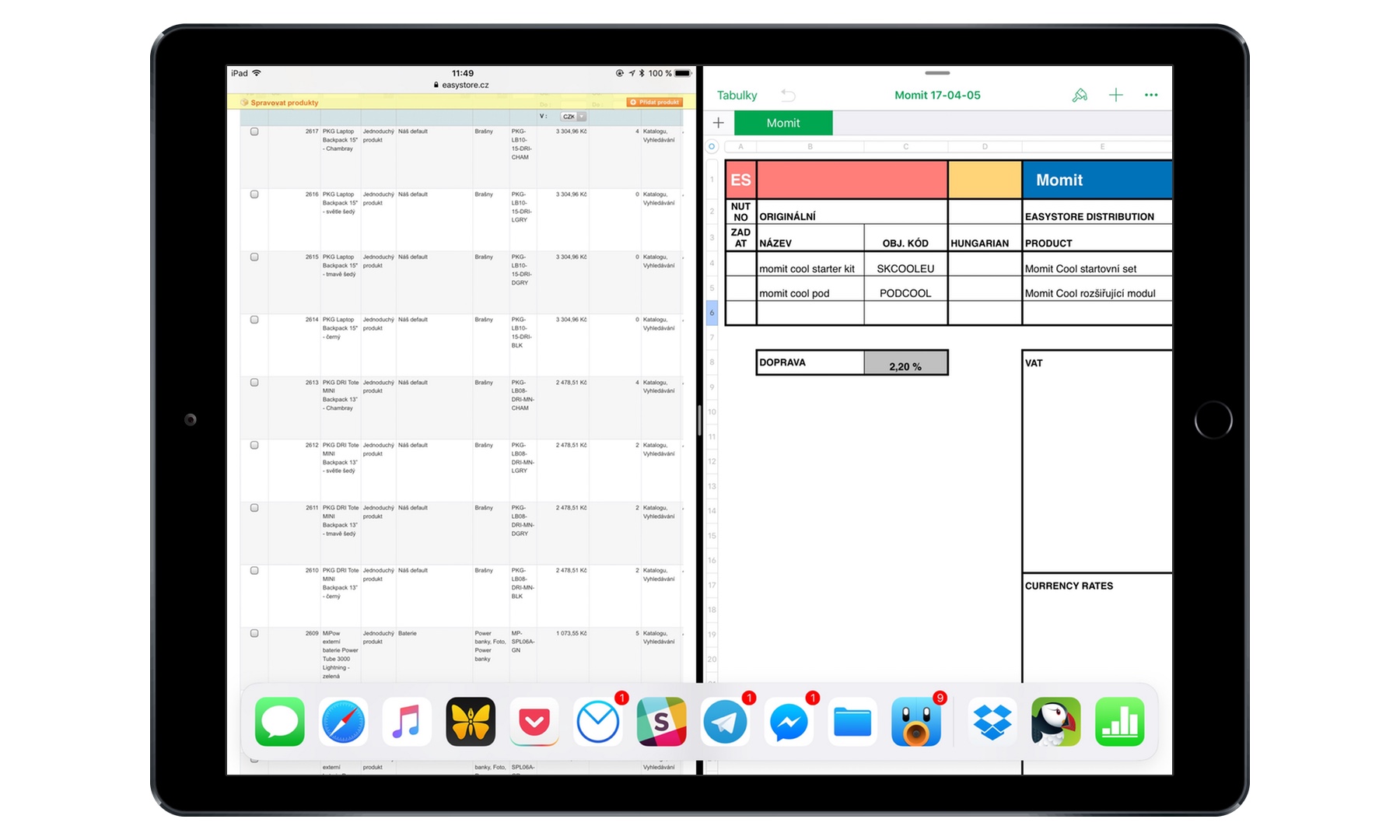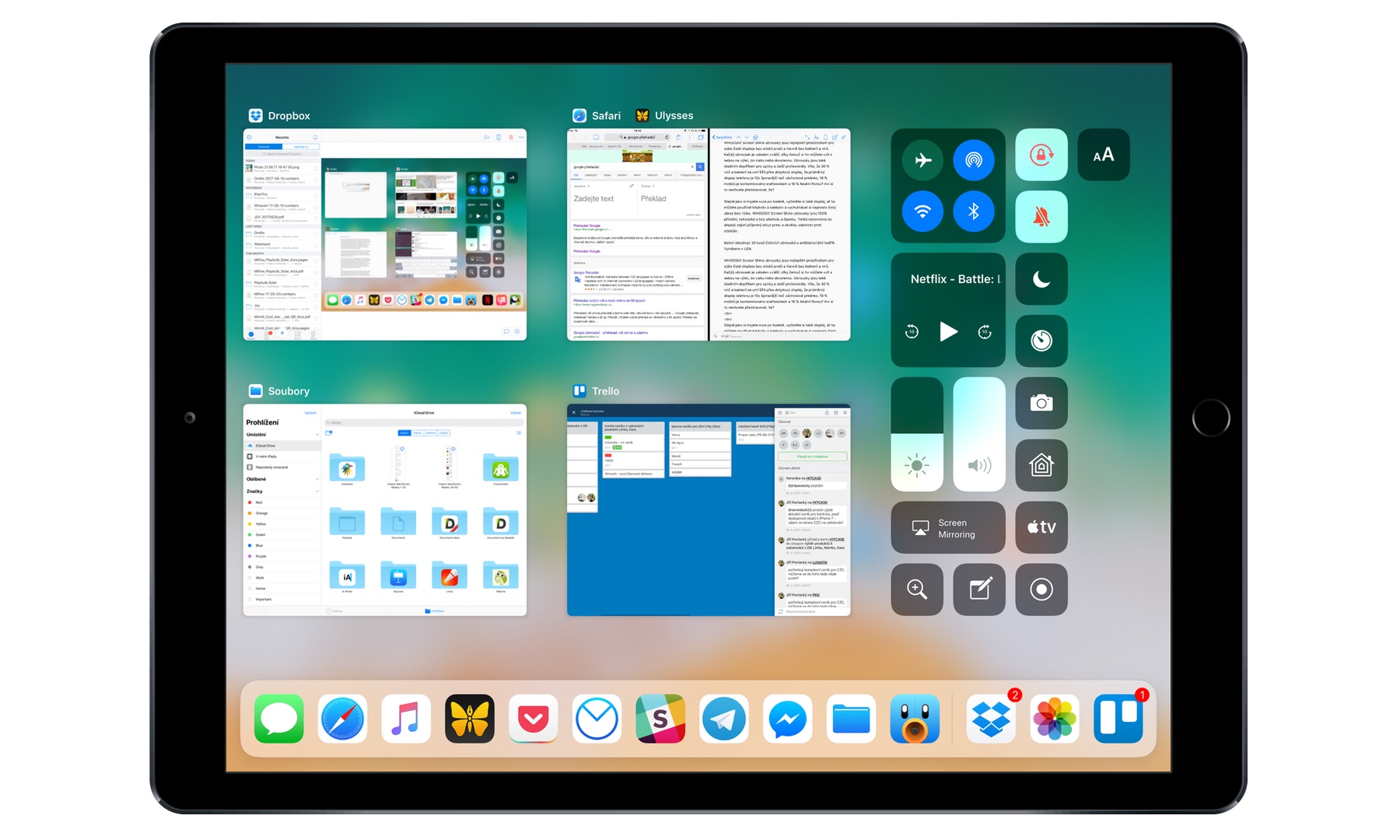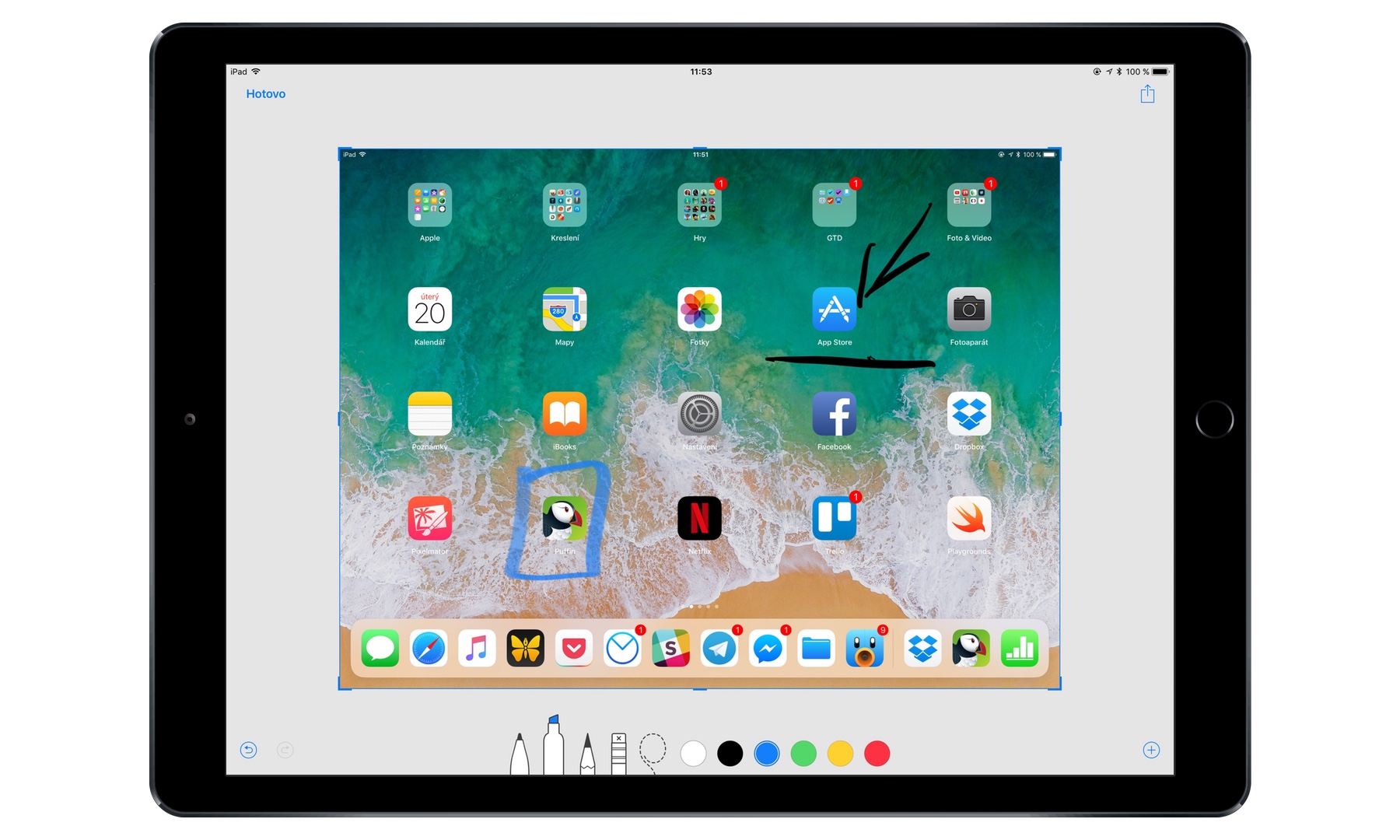As such, the iPad Pro offers incredible performance, which is comparable with some regular computers or a MacBook, so it is no longer a problem to edit a video in 4K on the iPad and switch to other applications for more demanding activities. However, the problem was often in the iOS operating system itself and in individual applications, which are sometimes too simple and do not offer more advanced options like some applications on macOS.
With these words I ended my article about using the iPad Pro as a primary work tool a fortnight ago. WITH with the arrival of iOS 11 however, everything changed and turned 180 degrees. It was clear that I couldn't publish an article criticizing iOS 10 when the iOS 11 developer beta came out the next day and I changed my mind.
On the other hand, I see it as a great opportunity to show how big a step iOS has made between versions 10 and 11, especially for iPads, which the new iOS 11 takes significantly further.
To work with the iPad
I fell in love with the 12-inch iPad Pro the moment Apple first introduced it. I was impressed by everything about it – the design, the weight, the quick response – but for a long time I ran into the problem of not knowing how to fit the large iPad Pro into my work workflow. I often experimented in different ways and tried to see if it actually worked, but more or less there were periods when I didn't take the iPad Pro out of the drawer for weeks, and weeks when I tried to take it to work as well.
More than a month ago, however, a new wave appeared, which was caused by a change of job. I used to work as a journalist in a national publishing house where I also had to use a Windows device. However, now I work at a company that is clearly associated with Apple products, so integrating the iPad into work deployments is much easier. At least that's what it looked like, so I tried to put the MacBook in the closet and go out with just the iPad Pro.
I work as a product manager. I test and list new products that are associated with Apple. In addition, I also prepare newsletters for subscribers and end customers. As a result, classic "office" activity is mixed with simple graphic operations. I told myself that I had to do it on the iPad Pro as well – I note that at that time we didn't know anything about iOS 11 – so I left the MacBook at home for a fortnight. With the iPad, I carried the Smart Keyboard, without which we probably cannot even talk about a replacement for a computer, and also the Apple Pencil. But more on that later.

Hurray for work
My job description is about writing texts, listing products in the Magento e-commerce system, creating newsletters and simple graphics. I exclusively use the Ulysses application for writing texts, both for the Markdown language, and for its existence on both iOS and macOS and the easy export of text for further use. Sometimes I also use applications from the iWork package, where synchronization across devices is again useful. I always have everything at hand, so when I replaced my MacBook with an iPad, there was no problem in that regard.
The first new procedures had to be discovered when listing products in Magento. Once I have the text for the product ready, I'm going to copy it right there. Magento runs in a web browser, so I open it in Safari. We have all the necessary documents stored and sorted in shared folders on Dropbox. Once someone makes a change, it will be visible to everyone who has access to it. Thanks to this, the information is always up to date.
Listing on MacBook: I list on the MacBook in such a way that I have Safari with Magento open on one desktop and a document with a price list on another desktop. Using gestures on the trackpad, I jump and copy the data I need at the moment with lightning speed. In the process, I also have to search the manufacturer's website for various features and specifications. On a computer, work is very fast in this regard, as switching between multiple applications or browser tabs is no problem.
Listing on iPad Pro with iOS 10: In the case of the iPad Pro, I tried two tactics. In the first case, I split the screen into two halves. One was running Magento and the other was an open spreadsheet in Numbers. Everything worked smoothly, except for the slightly tedious searching and copying of data. Our tables contain many cells and it will take some time to look up the data. It happened here and there that I even tapped something with my finger that I didn't want at all. In the end, however, I filled out everything I needed to.
In the second case, I tried to leave Magento stretched over the entire desktop and jumped to the Numbers application with a gesture. At first glance, it may seem similar to splitting the screen in half. However, the advantage is better orientation on the display and, finally, faster work. If you use the familiar Mac shortcut (CMD+TAB), you can jump between applications very easily. It also works with four fingers on the display, but if you work with the Smart Keyboard, the keyboard shortcut simply wins.
So you can copy the data in the same way as on a Mac, but it's worse when I need to open another tab in the browser in addition to Magento and the table and search for something on the web. Switching and layout options for applications and their windows is more convenient on the Mac. The iPad Pro can also handle a large number of tabs in Safari and keep many apps running in the background, but in my case the work in the mentioned case is not as fast as on the Mac.

A new level with iOS 11
Product listing on iPad Pro with iOS 11: I tried the same product listing process as described above on the new operating system after the release of the iOS 11 developer beta, and I immediately felt that this is much closer to the Mac in terms of multitasking. Many actions on the iPad are more nimble and faster. I will try to demonstrate it on my traditional workflow, where many major or minor innovations help me, or help the iPad to catch up with the Mac.
When a new product comes to my desk for testing and listing, I usually have to rely on the manufacturer's documentation, which can be from anywhere. That's why I have Google Translate open, which I sometimes use to help myself. In the mode of two applications side by side, on the iPad Pro I have Safari on one side and the translator on the other. In Safari, I mark the text and smoothly drag it with my finger into the translator window - that's the first new feature in iOS 11: drag&drop. It also works with everything, not just text.
I then usually insert the text from the translator into the Ulysses application, which means that on the one hand I will replace Safari with just this "writing" application. Another novelty of iOS 11, which is the dock, is a well-known thing from the Mac. Just flick your finger from the bottom of the display anytime and anywhere and a dock with selected applications will pop up. I have Ulysses among them, so I just swipe, drag and drop the app instead of Safari, and get on with the job. No more closing all windows and searching for the icon of the desired application.
In the same way, I often launch the Pocket application during work, where I save various texts and materials that I return to. In addition, I can call up the application from the dock as a floating window above two already open ones, so I actually don't even have to leave Safari and Ulysses next to each other at all. I'll just check something in Pocket and continue again.

That iOS 11 is much better adapted to work in multiple applications at the same time is also shown by the redesigned operation of multitasking. When I have two side-by-side apps open and I press the home button, that entire desktop is saved to memory - two specific side-by-side apps that I can easily bring up again. When I'm working in Safari with Magento, I have Numbers with a price list open next to it and I need to jump to Mail, for example, and then I can get back to work very quickly. These are the things that make work on the iPad Pro significantly more efficient.
Personally, I'm still very much looking forward to the new system application Files (Files), which is again reminiscent of the Mac and its Finder. For now it only has limited access to iCloud Drive in developer beta, but in the future Files should integrate all the cloud and other services where you can store your data, so I'm curious to see if it can improve my workflow again, since at least I work with Dropbox regularly . Greater integration into the system will be a welcome innovation.
At the moment, I am actually solving only one major problem on the iPad from a work point of view, and that is that Magento requires Flash to upload images to the system. Then I have to turn on the browser instead of Safari Puffin web browser, which Flash supports (there are others). And here we come to my next activity - working with images.
Graphics on iPad Pro
Since I don't need to work with curves, vectors, layers or anything similarly graphically advanced, I can get by with relatively simple tools. Even the App Store for iPad is already crowded with graphic applications, so it may not be easy to choose the right one. I tried well-known applications from Adobe, the popular Pixelmator or even system adjustments in Photos, but in the end I came to the conclusion that everything is too tedious.
Finally, I'm on Twitter from Honza Kučerík, with whom we coincidentally collaborated on series on the deployment of Apple products in business, got a tip about the Workflow app. At that point, I was kind of cursing myself for not realizing it sooner, because that's exactly what I was looking for. I usually just need to crop, shrink or add images together, which Workflow handles with ease.
Since Workflow can also access Dropbox, from where I often take graphics, everything works very efficiently and, moreover, without much input from me. You only set up the workflow once and then it works for you. You just can't shrink a photo faster on the iPad. The Workflow application, which has belonged to Apple since March, is not among the news in iOS 11, but it complements the new system appropriately.
More pencils
I mentioned at the beginning that in addition to the Smart Keyboard with the iPad Pro, I also carry an Apple Pencil. I bought an apple pencil in the beginning mainly out of curiosity, I'm not a great draftsman, but I cut a picture from time to time. However, iOS 11 helps me use the Pencil a lot more, for non-drawing activities.
When you have iOS 11 on your iPad Pro and you tap the screen with the pencil while the screen is locked and off, a new note window will open and you can immediately start writing or drawing. In addition, both activities can now be done very easily within a single sheet, so Notes can be used to its full potential. This experience is often at least as quick as starting to write in a paper notebook. If you mainly work electronically and "notate", this can also be a fairly significant improvement.

I have to mention another new feature in iOS 11, which is related to taking screenshots. When you take a screenshot, the given print is not only saved in the library, but its preview remains in the lower left corner of the screen, from where you can work with it immediately. With the Pencil in your hand, you can easily add notes and send them directly to a friend who is waiting for advice. There are many uses, but quick and easy editing of screenshots can also turn out to be a big deal, even if it sounds banal. I'm glad that the use for the Apple Pencil is increasing on the iPad Pro.
A different approach
So, for my workload, I generally have no problem switching to the iPad Pro and doing everything that is needed. With the arrival of iOS 11, working on an Apple tablet has in many ways become much closer to working on a Mac, which is good from my point of view if I am dealing with deploying an iPad in a work workflow.
However, there is another thing that personally attracts me to using an iPad for work, and that is the principle of functioning on a tablet. In iOS, as it is built, there are far fewer distracting elements compared to Mac, thanks to which I can focus much more on the work itself. When I'm working on a Mac, I have multiple windows and other desktops open. My attention wanders from side to side.
On the contrary, in the case of the iPad, I have only one window open and I am fully focused on what I am doing. For example, when I write in Ulysses, I really just write and mostly listen to music. When I open Ulysses on my Mac, my eyes dart all over the place, knowing full well that I have Twitter, Facebook, or YouTube right next to me. Although it is easy to skip even on an iPad, the tablet environment simply encourages this much less.
However, with the arrival of the dock in iOS 11, I have to admit that the situation has gotten somewhat worse on iOS as well. Suddenly, switching to another application is a little easier, so I have to be more careful. Thanks Peter Mára's vlogs however, I came across an interesting one the Freedom service, which with its own VPN can block access to the Internet, be it social networks or other apps that might distract you. Freedom is also for Mac.
What to work with?
You're probably now wondering if I really replaced my MacBook at work with an iPad Pro. To some extent yes and no. It's definitely better for me to work on iOS 11 than the original ten. It's all about the details and everyone is looking and needing something different. As soon as a tiny part is changed, it will be reflected everywhere, for example the mentioned work with two windows and the dock.
In any case, I rather humbly returned to the MacBook after the experiment with the iPad Pro. But with one big difference from before...
I described at the beginning that I had an ambivalent relationship with the large iPad from the beginning. Sometimes I used it more, sometimes less. With iOS 11 I try to use it every day. Although I still carry a MacBook in my backpack, I divide the activities and workload. If I were to make some personal graph and stats pie, I've been using the iPad Pro for over two months now. But I still don't dare to leave the MacBook at home for good, because I feel like I might miss macOS at times.
Anyway, the more I used the iPad Pro, the more I felt the need to buy a more powerful charger, which I would like to mention in conclusion as a recommendation. Buying a more powerful 29W USB-C charger with which you can charge a large iPad significantly faster, in my experience I consider it a necessity. The classic 12W charger that Apple bundles with the iPad Pro isn't a complete slug, but when fully deployed, I've had it happen a few times that it only managed to keep the iPad alive but stopped charging, which can be a problem.
From my, so far, only short experience with iOS 11, I can state that the iPad (Pro) is getting closer to the Mac and for many users it will certainly find justification as the main work tool. I don't dare to shout that the era of computers is over and they will begin to be replaced en masse by iPads, but the apple tablet is definitely no longer just about consuming media content.
"However, with the arrival of iOS 11, everything changed and turned 360 degrees."
So nothing really changed when it was rotated 360 degrees?
Isn't that too much, Anton Pavlovic?
everything changed, but the author still didn't replace the PC with an iPad, so nothing actually changed in the end. that's why 360 degrees ;]
If it appears on iOS:
– Windows virtualization, (I don't believe that SAP would release a version of the frontend for iOS is the music of the future and that everyone would switch to HCP en masse, if only because it is a bugged, expensive beta version),
– Proper IDE (Python, Wiring, Swift, ABAP / Java)
I can imagine replacing the MacBook. I like iOS 11 in this respect, even though the most important thing will probably come in iOS 12.
I agree. I miss the IDE on iOS. But again, it is enough for the work mentioned above. Not for mine.
But why? Why do you want to replace your MacBook with an iPad? I would like to hear the reasons. Due to the design, the iPad is very fragile compared to the MacBook, which can withstand much worse handling, and the principle of the device is that it is a mobile product. The reality is that sooner or later something happens along the way. You still have a dirty worktop and you have to clean it from your fingers. You have two UIs that are completely unnecessary and confusing.
Comfort and laziness. Do not really expect from me that it is because of ergonomics, design and other "super" arguments. I just need something to do basic admin stuff on, I can run a virtual machine on it, but to make it as light as possible so I don't have to drag it around like a cat and kittens. I have an MBA, it's great, but I'd leave it at home, the iPad would really be enough for me with clients, and as a "bonus" I could take notes in meetings with the Apple Pencil (at the moment, if I pull out a notepad and launch Pages, look at me strangely enough).
Anyway, just because I can imagine it doesn't mean that when it does, I won't "discard" it after a few days of use and wait for the next iOS. Primarily just thinking and sharing my opinion on how I might plug an iPad into my work WF self.
I'm sorry, but it's just so mind-boggling. He would probably be able to handle it if it was an emergency solution for a few crowns. But the price for a 256GB Ipad Pro 12,9 plus Pencil plus keyboard and we're close to 35. For that money, I can easily get a luxury laptop from Apple. Unfortunately, I can do the work that the author is doing so complicatedly and painstakingly on my 10-year-old HP with Ubuntu with my finger in my nose. But it's a fact that I'm not going to write an article on the Internet about how I almost replaced a notepad with a tablet. Unfortunately, the fact that I have to constantly put my hand from the keyboard to the display and click something there would probably bother me the most. And on a 12,9 iPad, the distance is really big. See how little movement you have to make with the mouse to move the cursor from the bottom left corner to the top right. Centimeters. Scrolling the mouse wheel is millimeter movements. You have 10-15 cm from the keyboard to the mouse. And I'm not talking about the fact that you can't choose the tilt angle of the tablet on an iPad with a connected keyboard. This is the absolute basis for ergonomics. In my opinion, it reminds me of the famous scratching with the left foot behind the right ear. But when it suits someone.
Why didn't Apple actually make iOS as a touch screen gui version of OSX? Because of the battery? Processor?
1. iOS is basically OSX. Cropped of course.
2. It would be really difficult to control
3. due to the fact that OS X would expose the flashlight quite quickly
In principle. I'll make hardware A. I'll give it software A. I'll make hardware B. Logically, I have to tailor the software to it, so B. Then there are people who will make hardware C, D, E, F, and G and stuff software Z on top of everything.
I wonder why replace a laptop with a tablet? The only reason I can think of is the price - I don't want to have two devices for my brother's 80.
I can't work with the device I'm currently working on? Each is used differently, each has its own advantages – I prefer to take a tablet for trips or meetings, a laptop or a desktop computer for intensive creation and insertion of content.
Can the iPad Pro replace the MacBook?
You've been doing this for a long time here and elsewhere too. I would change the question a bit.
Can the MacBook replace the iPad Pro?
At once, when we think about it, we find out that it can't - each device is completely different, focused on certain tasks and specific use.
In some way, those devices meet and there then arises a kind of space of replacing one with the other and vice versa, but it will always depend on the exact use of the given user.
masochism.